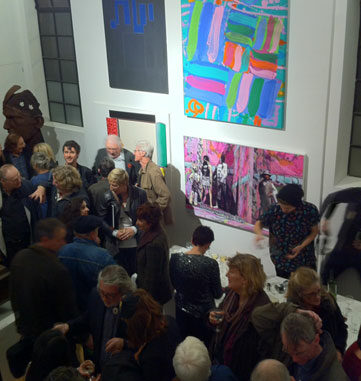
There was a packed crowd for the private view on 2nd November at Part Two of this very popular and prestigious exhibition. Bodies filled every available corner, huddled into each stairway and spilled out into the street such was the enthusiasm of the crowd to view the images and mingle with such creative minds.
The London Group are a select group of extremely accomplished and diverse visual artists. Membership is through a democratic system of nominations and subsequent selection. Formed in 1913 as a reaction to the power of The Royal Academy, the group have been meeting and exhibiting contemporary innovative work ever since. Every two years their annual show is open to submissions from outside the group, those selected enjoy the honour to have their work hung alongside various forms of diverse works ranging from small watercolours to sculptures of awe inspiring stature and concept, from this very friendly band of creative people. The outside selectors for the open submissions this year were William Feaver, writer artist and critic, and Jenni Lomax, Director of Camden Arts Centre. The show runs for two ten day periods and I was lucky enough to have had one image selected for Part Two.
The Cello Factory is more than a simple white cube space; it has a gallery where work is also hung, this is reached by a small flight of stairs and also gives a different perspective from which to view the work below. An intimate room up another small flight of stairs shows a continuous digital loop of further work from each exhibitor.
This room remained amazingly quiet, even at this busy private view here was a space to sit comfortably and reflect on the work being shown on the screen; yes, as often is the case images viewed digitally don’t always appear as they do in reality: that is as they are viewed in the gallery below. Later in the week when I was taking a turn at invigilation one particular visitor explained to me that he enjoyed watching the projected images and then went down to explore the work further; which seemed to me to be an interesting way to disseminate the variety of work on show.
The format of this gallery creates spaces to discover and be amazed by the multifaceted visual creations. As is my preference the works were titled, some giving away hints of their meaning and context, however most interpretation was left to the viewer to decipher and contemplate.
Three works I found particularly inspiring:
The small intimate series of images by Anieszka Kolek which appear with a cursory glance to be calm beautiful gentle watercolours in soft pastel hues of blues and greys; however look further into the images and played out are scenes of utter sadness and despair. Where I felt a helpless onlooker; the works are entitled Stoned to death, Village of Mullah Quilli, Afghanistan, 2010.
By contrast in the centre of the main room was a huge contraption of bottles, pipes and wooden keys topped with a huge air filled balloon by Daniel Knight entitled Prototype Number Two. This playful piece encouraged the viewer to interact. Pressing the keys resulted in deep notes that boomed out to fill the room; not only a sculptural piece of work reminiscent of a mad scientist’s experimental contraption but a sculpture where every individual viewing it could create their own sound performance. As the wine flowed and spirits grew these sounds filled the room as people clamoured to perform.
A third piece of work I was drawn to was that of Linda Litchfield, entitled Dated Paper and Stitch. Train tickets and Travel cards are pinned within a frame in lines of date order. These were then hand stitched with the memories of that journey and subsequent encounters of the day. One had taken her to visit the dentist, another- drinks with friends, yet another ticket tells us a funeral had been attended. The combination of the banal cards and the carefully stitched memories entwined within them produces a work that holds your attention. The task of tying together with thread a disposable ticket and the long held memories are echoed in the length of time it must have taken to embroider these simple everyday pieces of printed paper. The viewer begins to feel they have been allowed into this individual’s personal diary and you cannot help but build up a narrative of her character and life.
Like many other mixed shows I have viewed recently the photographic, oils, pastels and many other processes sat comfortably together; an excellent curatorial couple composed a harmonious group of works that flowed in content and context.
This exhibition runs until 10th November at The Cello Factory.


Leave a Reply